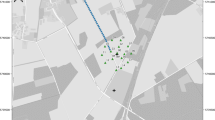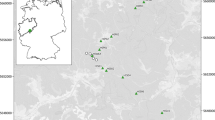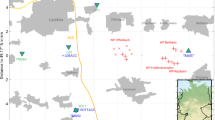Abstract
We present a case study on the detection and quantification of seismic signals induced by operating wind turbines (WTs). We spatially locate the sources of such signals in data which were recorded at 11 seismic stations in 2011 and 2012 during the TIMO project (Deep Structure of the Central Upper Rhine Graben). During this time period, four wind farms with altogether 12 WTs were in operation near the town of Landau, Southwest Germany. We locate WTs as sources of continuous seismic signals by application of seismic interferometry and migration of the energy found in cross-correlograms. A clear increase of emitted seismic energy with rotor speed confirms that the observed signal is induced by WTs. We can clearly distinguish wind farms consisting of different types of WTs (different hub height and rotor diameter) corresponding to different stable frequency bands (1.3–1.6 Hz, 1.75–1.95 Hz and 2.0–2.2 Hz) which do not depend on wind speed. The peak frequency apparently is controlled by the elastic eigenmodes of the structure rather than the passing of blades at the tower. From this we conclude that vibrations are coupled into the ground at the foundation and propagate as Rayleigh waves (and not as infrasound). The migration velocity of 320 m/s corresponds to their group velocity. The applied migration method can contribute to the assessment of local sources of seismic noise. This topic gets growing attention in the seismological community. In particular, the recent boost of newly installed wind farms is a threat to seismological observatories such as the Black Forest Observatory (BFO) and the Gräfenberg array (GRF) or gravitational wave observatories (e.g. LIGO, VIRGO) in terms of a sensitivity degradation of such observatories.










Similar content being viewed by others
References
Ballmer S, Wolfe CJ, Okubo PG, Haney MM, Thurber CH (2013) Ambient seismic noise interferometry in Hawai’i reveals long-range observability of volcanic tremor. Geophys J Int 194:512–523
Droznin DV, Shapiro NM, Droznina SY, Senyukov SL, Gordeev EIV, Chebrov N (2015) Detecting and locating volcanic tremors on the Klyuchevskoy group of volcanoes (Kamchatka) based on correlations of continuous seismic records. Geophys J Int 203:1001–1010
Flores Estrella H, Korn M, Alberts K (2017) Analysis of the influence of wind turbine noise on seismic recordings at two wind parks in Germany. J Geosci Environ Protect 5:76–91. https://doi.org/10.4236/gep.2017.55006
Gassenmeier M, Sens Schönfelder C, Delatre M, Korn M (2015) Monitoring of environmental influences on seismic velocity at the geological storage site for CO2 in Ketzin (Germany) with ambient seismic noise. Geophys J Int 200:524–533. https://doi.org/10.1093/gji/ggu413
Groos JC, Ritter JRR (2009) Time domain classification and quantification of seismic noise in an urban environment. Geophys J Int 179:1213–1231
Groos J (2010) Broadband seismic noise: classification and green’s function estimation. Dissertation at the Karlsruhe Institute of Technology, KITopen ID: 1000021099. https://publikationen.bibliothek.kit.edu/1000021099
Horstmann T, Forbriger T (2010) Verbesserung einer Kreuzkorrelationsanalyse mit ungünstiger Quellverteilung durch Slant Stack und Migrationsanalyse. DGG Mittlg 2/2010:19–28. https://doi.org/10.5445/IR/1000021244
Li KL, Sgattoni G, Sadeghisorkhani H, Roberts R, Gudmundsson O (2017) A double-correlation tremor-location method. Geophys J Int 208:1231–1236
Mündel R (2009) Überwachung zeitlicher Änderungen in der Ausbreitung elastischer Wellen als Folge von CO2-Einlagerungen im Untergrund. Diplomarbeit, Institut für Geophysik und Geologie, Universität Leipzig
Neuffer T, Kremers S (2017) How wind turbines affect the performance of seismic monitoring stations and networks. Geophys J Int 211:1319–1327. https://doi.org/10.1093/gji/ggx370
Pilger C, Ceranna L (2017) The influence of periodic wind turbine noise on infrasound array measurements. J Sound Vib 388:188–200. https://doi.org/10.1016/j.jsv.2016.10.027
Ritter JRR (2011) Konzeptionelle Ansätze zur Überwachung induzierter Seismizität im Oberrheingraben in Rheinland-Pfalz. Mainzer geowiss Mitt 39:157–176
Saccorotti G, Piccinini D, Cauchie L, Fiori I (2011) Seismicnoise by wind farms: a case study from the virgo gravitational wave observatory, Italy. Bull Seismol Soc Am 101(2):558–578
Schofield R (2001) Seismic measurements at the stateline wind project. Rept No LIGO T020104-00-Z, Laser Interferometer Gravitational-Wave Observatory, available at http://www.ligocaltechedu/docs/T/T01010400pdf
Sgattoni G, Gudmundsson O, Einarsson P, Federico Lucchi F, Li KL, Sadeghisorkhani H, Roberts R, Tryggvason A (2017) The 2011 unrest at Katla volcano: characterization and interpretation of the tremor sources. J Volcanol Geotherm Res 33:63–78
Shapiro NM, Ritzwoller MH, Bensen GD (2006) Source location of the 26 sec microseos, from cross-correlations of ambient seismic noise. Geophys Res Lett 33:L18310. https://doi.org/10.1029/2006GL027010
Spies T, Schlittenhardt J, Schmidt B (2017) Abschlussbericht für das Verbundprojekt MAGS2: Mikroseismische Aktivität geothermischer Systeme 2 (MAGS2) - vom Einzelsystem zur großräumigen Nutzung : Einzelprojekt EP4: Ermittlung der seismischen gefährdung bei tiefer geothermischer Energiegewinnung unter Berücksichtigung der regionalen und lokalen geologisch-tektonischen Strukturen. https://zsn.bgr.de
Stammler K, Ceranna L (2016) Influence of wind turbines on seismic records of the Gräfenberg Array. Seismol Res Lett 87(5):1075–1081. https://doi.org/10.1785/0220160049
Stein F (2013) Determination of seismic waveforms using passive seismic interferometry around Landau, SW Germany. Diploma Thesis at the Karlsruhe Institute of Technology, KITopen ID: 1000037676 https://publikationen.bibliothek.kit.edu/1000037676
Styles P, England R, Stimpson IG, Toon SM, Bowers D, Hayes M (2005) Microseismic and infrasound monitoring of low frequency noise and vibrations from windfarms: recommendations on the siting of windfarms in the vicinity of Eskdalemuir, Scotland. Keele University, UK. https://www.keele.ac.uk/geophysics/appliedseismology/wind/Final_Report.pdf
Vasterling M, Wegler U, Becker J, Bruestle A, Bischoff M (2017) Real-time envelope cross-correlation detector: application to induced seismicity in the Insheim and Landau deep geothermal reservoirs. J Seismol 21:193–208. https://doi.org/10.1007/s10950-016-9597-1
Xi Engineering Consultants Ltd (2014) Seismic vibration produced by wind turbines in the Eskdalemuir region. https://www.gov.scot/Topics/Business-Industry/Energy/Infrastructure/Energy-Consents/Guidance/reportseismicvibrations
Zeng X, Ni S (2010) A persistent localized microseismic source near the Kyushu Island, Japan. Geophys Res Lett 37:L24307. https://doi.org/10.1029/2010GL045774
Zieger T, Ritter J (2017) Influence of wind turbines on seismic stations in the upper rhine graben, SW Germany. J Seismol https://doi.org/10.1007/s10950-017-9694-9
Acknowledgements
Seismic data were provided by the “Erdbebendienst Südwest”, the “Federal Institute for Geosciences and Natural Resources (BGR)” and the “Karlsruher Broadband Array (KABBA)”. We thank pfalzwind GmbH (Ludwigshafen/Germany) for the provision of data and their support of this work. We would like to thank the two anonymous reviewers and the editor for their helpful and constructive suggestions and comments.
Funding
T.Z. was financed by the project “TremAc”, which is funded by the Federal Republic of Germany. Awarding authority: The Federal Ministry for Economic Affairs and Energy based on a resolution of the German Bundestag.
Author information
Authors and Affiliations
Corresponding author
Rights and permissions
About this article
Cite this article
Friedrich, T., Zieger, T., Forbriger, T. et al. Locating wind farms by seismic interferometry and migration. J Seismol 22, 1469–1483 (2018). https://doi.org/10.1007/s10950-018-9779-0
Received:
Accepted:
Published:
Issue Date:
DOI: https://doi.org/10.1007/s10950-018-9779-0




